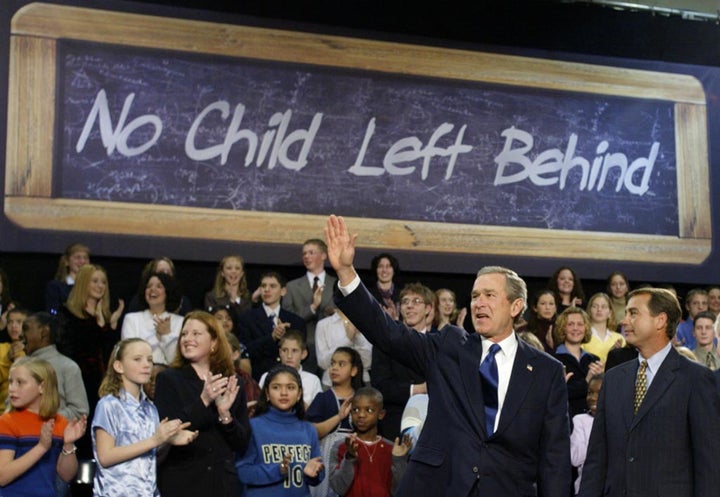
On January 8, 2002, President George W. Bush signed No Child Left Behind into law.
NCLB, as it was known, is the worst federal education legislation ever passed by Congress. It was punitive, harsh, stupid, ignorant about pedagogy and motivation, and ultimately a dismal failure. Those who still admire NCLB either helped write it, or were paid to like it, or were profiting from it.
It was Bush’s signature issue. He said it would end “the soft bigotry of low expectations.” It didn’t.
When he campaigned for the presidency, he and his surrogates claimed there had been a “Texas miracle.” There wasn’t.
All that was needed, they said, was to test every child in grades 3-8 every year in reading and math. Make the results for schools public. Reward schools that raised scores. Punish schools for lower scores. Then watch as test scores soar, graduation rates rise, and achievement gaps closed. It didn’t happen in Texas nor in the nation.
“NCLB was a ticking time bomb, set to destroy American public education by setting an impossible goal.”
The theory was simple, simplistic, and stupid: test, then punish or reward.
Congress bought the claim of the Texas miracle and passed NCLB, co-sponsored by leading Republicans and Democrats, including Ted Kennedy of Massachusetts and Congressman George Miller of California.
Congress mandated that every student in every school must be proficient on standardized tests of reading or math or the school was a failure, facing closure or privatization by 2014. NCLB was a ticking time bomb, set to destroy American public education by setting an impossible goal, one that almost every school in every state would ultimately fail.
It was the largest expansion of the federal role in history. It was the largest intrusion of the federal government into state and local education decision-making ever.
Bush’s original proposal was a 28-page document. (I was invited to the White House ceremony where it was unveiled; at the time, I was a member in good standing of the conservative policy elite). By the time the bill passed, the new law exceeded 1,000 pages. A Republican Congressman from Colorado told me that he thought he was the only member who read the whole bill (he voted against it.)
NCLB took the place of the Elementary and Secondary Education Act of 1965, a component of President Lyndon B. Johnson’s “Great Society” Program. The primary purpose of ESEA was to send federal funds to the poorest districts. (During the Clinton administration, ESEA was renamed the Goals 2000 Act and incorporated the lofty education goals endorsed by the first Bush administration.
To learn more about this history and why NCLB failed, read my book “The Death and Life of the Great American School System: How Testing and Choice Are Undermining Education.” To learn more about the negative effects of NCLB, read Daniel Koretz’s new book, “The Testing Charade: Pretending to Make Schools Better.” To learn more about the unintended negative effects of accountability, google Richard Rothstein’s monograph “Holding Accountability to Account.”
This is what we got from NCLB: score inflation, cheating, narrowing the curriculum, obsession with test scores, more time devoted to testing, less time for the arts, physical education, history, civics, play, and anything else that was not tested. Among other consequences: demoralization of teachers, a national teacher shortage, more money for testing companies, and less money for teachers and class size reduction.
We also got a load of “reforms” that had no evidence to support them, such as closing schools, firing teachers and principals because of low scores, handing schools with low scores over to charter operators or the state.
NCLB, in turn, led to its ugly spawn, Race to the Top, which was even meaner and more punitive than NCLB. Race to the Top turned up the heat on test scores, making them the measure of teacher quality despite decades of social science that refuted that policy. More teachers and principals were fired, more public schools were closed, enrollments in professional education programs plummeted across the country.
NCLB was the Death Star of American education. Race to the Top was the Executioner, scouring the land with a giant scythe in search of teachers, principals, and schools to kill if student scores didn’t go up.
When the law was passed, I went to an event at the Willard Hotel in D.C. where key senators discussed it. One of them was Senator Lamar Alexander, former governor of Tennessee, former U.S. Secretary of Education (for whom I worked as Assistant Secretary of Education in charge of the Office of Education Research and Improvement). At the end of the panel, when it was time for questions, I asked Senator Alexander whether Congress really believed that every student in the nation would be proficient by 2014. He said that Congress knew they would not be, but “it’s good to have goals.”
